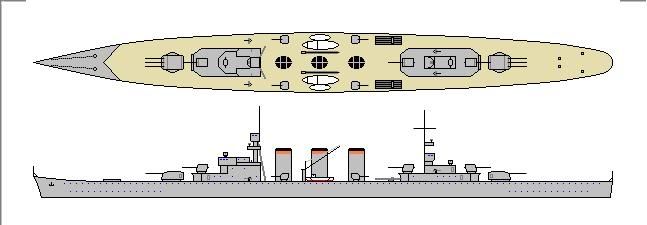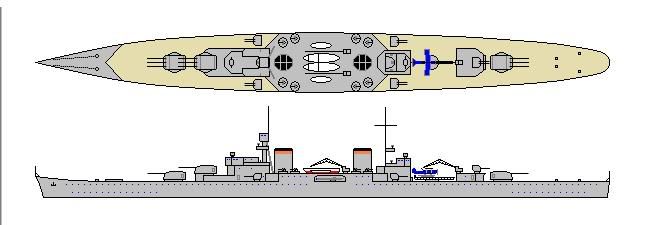Trincomalee pic for comparison...

And Agra...

Agra, laid down 1926
Length, 174.0 m x Beam, 17.4 m x Depth, 5.6 m
8035 tonnes normal displacement (7233 tonnes standard)
Main battery: 9 x 15.0-cm (3 x 3; 1 superfiring)
Secondary battery: 10 x 10.5-cm
AA battery: 8 x 3.5-cm
Light battery: 6 x 1.5-cm
Weight of broadside: 587 kg
8 TT, 55.0 cm
Main belt, 8.0 cm; ends unarmored
Armor deck, average 4.0 cm
Conning tower, 8.0 cm
Battery armor:
Main, 8.0 cm / secondary, 4.0 cm shields
AA, 2.0 cm shields / light guns, 2.0 cm shields
Maximum speed for 52021 shaft kw = 31.54 knots
Approximate cruising radius, 11000 nm / 12 knots
Typical complement: 424-552
Estimated cost, $9.560 million (£2.390 million)
Remarks:
Relative extent of belt armor, 108 percent of 'typical' coverage.
Ship has slow, easy roll; a good, steady gun platform.
Ship is roomy, with superior accommodation and working space.
Distribution of weights:
Percent
normal
displacement:
Armament ......................... 162 tonnes = 2 pct
Armor, total ..................... 1320 tonnes = 16 pct
Belt 469 tonnes = 6 pct
Deck 570 tonnes = 7 pct
C.T. 27 tonnes = 0 pct
Armament 254 tonnes = 3 pct
Machinery ........................ 2231 tonnes = 28 pct
Hull and fittings; equipment ..... 3202 tonnes = 40 pct
Fuel, ammunition, stores ......... 1070 tonnes = 13 pct
Miscellaneous weights ............ 50 tonnes = 1 pct
-----
8035 tonnes = 100 pct
Estimated metacentric height, 0.8 m
Displacement summary:
Light ship: 6965 tonnes
Standard displacement: 7233 tonnes
Normal service: 8035 tonnes
Full load: 8644 tonnes
Loading submergence 1841 tonnes/metre
+++++++++++++++++++++++++
Estimated overall survivability and seakeeping ability:
Relative margin of stability: 1.12
Shellfire needed to sink: 3769 kg = 80.3 x 15.0-cm shells
(Approximates weight of penetrating
shell hits needed to sink ship,
not counting critical hits)
Torpedoes needed to sink: 1.3
(Approximates number of 'typical'
torpedo hits needed to sink ship)
Relative steadiness as gun platform, 71 percent
(50 percent is 'average')
Relative rocking effect from firing to beam, 0.40
Relative quality as a seaboat: 1.06
+++++++++++++++++++++++++
Hull form characteristics:
Block coefficient: 0.47
Sharpness coefficient: 0.32
Hull speed coefficient 'M' = 8.71
'Natural speed' for length = 23.9 knots
Power going to wave formation
at top speed: 55 percent
Estimated hull characteristics and strength:
Relative underwater volume absorbed by
magazines and engineering spaces: 107 percent
Relative accommodation and working space: 137 percent
Displacement factor: 113 percent
(Displacement relative to loading factors)
Relative cross-sectional hull strength: 0.99
(Structure weight per square
metre of hull surface: 484 kg)
Relative longitudinal hull strength: 1.18
(for 5.30 m average freeboard;
freeboard adjustment +0.88 m)
Relative composite hull strength: 1.01
+++++++++++++++++++++++++
[Machine-readable parameters: Spring Style v. 1.2.1]
570.72 x 57.07 x 18.37; 17.38 -- Dimensions
0.47 -- Block coefficient
1926 -- Year laid down
31.54 / 11000 / 12.00; Oil-fired turbine or equivalent -- Speed / radius / cruise
50 tons -- Miscellaneous weights
++++++++++
9 x 5.91; 3; 1 -- Main battery; turrets; superfiring
:
10 x 4.13; 0 -- Secondary battery; turrets
Gun-shields
:
8 x 1.38 -- Tertiary (QF/AA) battery
Gun-shields
:
6 x 0.59 -- Fourth (light) battery
8 / 0 / 21.65 -- TT / submerged / size
++++++++++
3.15 / 0.00 / 0.00 / 0.00; 108 -- Belt armor; relative extent
1.57 / 3.15 -- Deck / CT
3.15 / 1.57 / 0.79 / 0.79 -- Battery armor
(Note: For portability, values are stored in Anglo-American units)
+++++++++++++++++++++++++++++++++++++++++++++++++++++++




Quoted
Originally posted by The Rock DoctorQuoted
It appears that India has a Type 0 slipway - perfect for building the launches - sitting idle in 1926. No SATSUMA authorization is required for a unit this size, so all the SAE has to do is place the order and show me the rupees. I can sim up a version with 2x2 40mm guns for you easily enough.Quoted
Glad you like Agra. I'm happy with her appearance - seems to blend my cruiser evolution and the Akbar two-funnel look nicely.Quoted
Uh? Torpedos on a 31+kn craft are a defensive measure?!Quoted
IIRC no slip is necessary for small wooden crafts if they are not build faster than 1 craft per 3 factories per month. Could be wrong, thoughQuoted
Quoted
I just think a 10,5cm gun is way too large and heavy for such a vessel {L-1} and would have negative impact on their seakeeping. Even a 88mm gun would be too much, methinks. Given the designs task I doubt anything larger than light AA guns of 40mm and smaller are necessary.Quoted
Maybe the thinking will be different when the cruiser-minelayers get built.
Quoted
And I still think the 150mm guns should be 2 pixels thick.Quoted
I like gun shields